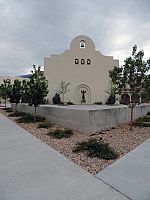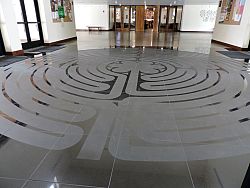Year of Faith pilgrimage: Saint Francis of Assisi Parish
(Editor’s note: For the Year of Faith, which ends Nov. 24, Bishop John C. Wester has designated 12 churches in the Diocese of Salt Lake City as pilgrimage sites. This article is one in a series about the sites. More information can be found at http://www.dioslc.org/images/year-of-faith/pilgrimage/Year%20of%20Faith%20Passport%20Booklet%20Version%20English.pdf.)
By Marie Mischel
Intermountain Catholic
OREM — The labyrinth winds its way back, forth and around, gray on the black marble floor, leading first straight toward the center, then north before a hairpin turn south, only to return to an easterly direction. Walking this winding way while praying is a perfect pilgrimage activity, opening a travel-stiffened body and mind to the Holy Spirit.
Labyrinths can be found in cultures as diverse as the Hindus of India and ancient Crete. By the Middle Ages, cathedrals incorporated labyrinths in their design as a substitute for making the perilous pilgrimage to Jerusalem. Utah’s newest church, Saint Francis of Assisi in Orem, welcomes visitors with a labyrinth just inside the main doors.
The circular path is also symbolic of the parish’s history, which has deep roots. The first Catholics known to visit the area were those in the Domínguez-Escalante Expedition. Led by two Franciscan priests, Francisco Atanasio Domínguez and Silvestre Vélez de Escalante, the group entered Utah Valley on Sept. 23, 1776. However, it wasn’t until 1873 that Mass was regularly celebrated in the area. Father Lawrence Scanlan, later the first Bishop of Salt Lake, is listed in diocesan records as the parish’s first pastor.
From 1893 to 1900, priests from Salt Lake City visited Provo once a month. In 1914, Father Stanislaus Bona became the community’s first resident priest. By 1917, what was then known as Immaculate Conception Parish had been established in Provo. Five years later, a rectory was constructed at 172 North 500 West in Provo, along with a basement that served as the parish church until 1936.
The Franciscan influence continued in 1931, when members of the order were invited to Utah by the Right Rev. John J. Mitty, third Bishop of Salt Lake. Franciscan Father Victor Herring became pastor of the parish, which was renamed in honor of the religious order’s founder.
No less an authority than Pope Pius XI approved the Franciscans’ presence. In 1930, when Bishop Mitty had an audience with the Holy Father, "He himself asked me if there were any religious [priests] in the diocese. When I told him that your Province was contemplating taking one of the parishes he expressed great satisfaction at this decision," Bishop Mitty wrote to the Very Rev. Novatus Benzing, Provincial of the Franciscan Fathers of the Santa Barbara Province.
Five years after Fr. Herring arrived in Utah, the Spanish Mission-style church was dedicated by the Most Rev. James E. Kearney, fourth Bishop of Salt Lake.
Members of women religious orders played a large part in the parish’s history as well. From 1948 to 1955 the Franciscan Sisters of the Atonement taught kindergarten there, while Our Lady of Victory Noll Missionary Sisters served as catechists for nearly 50 years, beginning in 1954; and Franciscan Sisters of Perpetual Adoration administered at the parish’s school from 1955 to 1970.
The sisters’ withdrawal from the school, combined with increasing operation costs, led to the school’s closure in 1971. The school was sold in the mid-1990s, and the Franciscan priests left the diocese about that same time.
The decision was made to build a new church in Orem after the parish outgrew the original church. The 70-year-old building was demolished on July 10, 2007.
"We had a lovely little church in Provo but it was just too small for us," said Father Garret Edmunds, the last Franciscan priest to serve as the parish’s pastor, in an interview published in the Intermountain Catholic after the Feb. 19, 2012 dedication of the new church by Bishop John C. Wester. "This has been a dream of the parish; it was my dream when I was here as pastor and to see it finally realized is a real blessing."
The dream took years to be fulfilled: Although the parish moved to Orem in 2007, construction plans didn’t get underway until 2008, and the groundbreaking didn’t occur until 2011. During those years, Mass was celebrated in the gymnasium that had been constructed on the property.
Raising funds for construction of the new church was a project for the entire parish, English-speaking and Spanish-speaking alike, said Father David Bittmenn, pastor, according to the Intermountain Catholic article.
"The community knew that it was a challenge and they stepped up and they really worked hard," Fr. Bittmenn said. "This is their place. They’ve built it for them and their children. ... We feel like we’ve been on a pilgrimage for a while, from Provo to here to the gym, so finally we’re entering the house of God."
Today’s pilgrims to St. Francis of Assisi Catholic Church will find not only the labyrinth, but numerous other religious symbols as well, particularly in the murals adorning each wall. The murals, are full of detail – an hour could be spent simply contemplating the scene behind the altar, which depicts a group of people along the path to the crucifix. Created by artist Jim McGee, the mural weaves Biblical details such as a lantern with modern-day images such as a cell phone. All the murals are described in a 20-page booklet that can be found in the rack just inside the entryway.
Those seeking a quiet pilgrimage may wish to consider going on a weekday, for St. Francis of Assisi is a vibrant parish with many scheduled activities. On the Saturday of my visit, a baptism, two quinceañeras and a wedding took place. If the main church is in use, pilgrims may pray at the day chapel, on the south side of the building.
IF YOU GO:
Saint Francis of Assisi Catholic Church is located at 65 East 500 North in Orem. Daily Masses are Monday – Friday, 9 a.m. in English and 6:30 p.m. in Spanish; Saturday Vigil is 5:30 p.m. in English and 7 p.m. in Spanish; and Sunday Masses are 8:30 and 10:30 a.m. in English and 12:30 and 3 p.m. in Spanish. The church is in a residential area about two miles from Interstate 15; restaurants and motels are located nearby.
(Unless otherwise noted, historical information in this article was taken from "Salt of the Earth: The History of the Catholic Church in Utah, 1776-2007," by Bernice Maher Mooney and Msgr. J. Terrence Fitzgerald.)
© Copyright 2024 The Diocese of Salt Lake City. All rights reserved.



Stay Connected With Us